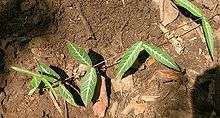Hemidesmus indicus
| Indian sarsaparilla | |
|---|---|
 | |
| Scientific classification | |
| Kingdom: | Plantae |
| (unranked): | Angiosperms |
| (unranked): | Eudicots |
| (unranked): | Asterids |
| Order: | Gentianales |
| Family: | Apocynaceae |
| Genus: | Hemidesmus |
| Species: | H. indicus |
| Binomial name | |
| Hemidesmus indicus | |
| Synonyms | |
| |
Hemidesmus indicus, Indian sarsaparilla ((Tamil: நன்னாரி “nannaari”/ நன்நெட்டி “nannetti”, Telugu: నన్నారి Malayalam: നറുനീണ്ടി, Kannada: ಹಾಲುಬಳ್ಳಿ Haaluballi, क्षीरिणी Kshirini, कराला Karala,اُشبا Punjabi),(sinhala: ඉරමුසු Iramusu)) is a species of plant that is found in South Asia. It is a slender, laticiferous, twining, sometimes prostrate or semi-erect shrub. Roots are woody and aromatic. The stem is numerous, slender, terete, thickened at the nodes. The leaves are opposite, short-petioled, very variable, elliptic-oblong to linear-lanceolate. The flowers are greenish outside, purplish inside, crowded in sub-sessile axillary cymes. It occurs over the greater part of India, from the upper Gangetic plain eastwards to Assam and in some places in central, western and South India.
The root is a substitute for sarsaparilla (the dried root of the tropical species of Smilax, Smilacaceae; in India Smilax aspera L., and Smilax ovalifolia Roxb.). It should be distinguished from American Sarsaparilla Smilax aristolochiifolia Mill. and Jamaican Sarsaparilla Smilax ornata Hook.f..[1]
Morphology[2]
The stem and branches of H. indicus twine anticlockwise, and are profusely laticiferous, elongate, narrow, teret and wiry of deep purple or purplish brown colour with the surface slightly ridged at the nodes. Roots are woody, slender and aromatic. Roots smell similar to camphor, hence the plant is also known as Kapoori. Leaves are simple, petioled, exstipulate, apiculate acute or obtuse, dark green above but paler and sometimes pubescent below. Leaves of the basal parts of the shoots are linear to lanceolate. Flowers may be greenish yellow to greenish purple outside, dull yellow to light purplish inside with calyx deeply five lobed. Corolla are fused and twice the number of calyx. Pistil is bicarpellary, with free ovaries, many ovuled with distinct styles. Fruits are two straight slender narrowly cylindrical widely divergent follicles. Seeds are many, flat, oblong, with a long tuft of white silky hairs.
The plant shows opposite decussate phyllotaxy, gamopetalous aestivation and cymose inflorescence.
Traditional uses
Hemidesmus indicus is used to make beverages and also used in traditional medicine. In Ayurveda it goes by the name of Ananthamoola (अनंत मूल), also known locally in Southern India as Naruneendi or Nannari,[3] (Sanskrit meaning: endless root). It is also known as Anant Vel (अनंतवेल)/Maeen Mool (माईन मूळ) in Marathi. In southern states of India (particularly Tamil Nadu), sarsaparilla roots are called Maahali or Mahani Kizhangu and in its pickled form is also served along with rice dishes. It is also called the false sarsaparilla. It is administered in the form of powder, infusion or decoction as syrup. It is one of the Rasayana plants of Ayurveda.[4] It is sometimes confused with another Ayurvedic herb called white sariva.
The extracts from the root are used in syrup with sugar and a dash of lemon (Sharbat) and served at most small refreshment shops in South India.
Chemical constituents
The roots of H. indicus contain hexatriacontane, lupeol, its octacosanoate, α-amyrin, β-amyrin, its acetate and sitosterol. It also contains new coumarino-lignoid-hemidesminine, hemidesmin I and hemidesmin II50, six pentacyclic triterpenes including two oleanenes, and three ursenes. The stem contains calogenin acetylcalogenin-3-0-β-D-digitoxopyrannosyl-0-β-D-digitoxopyronsyl-0-β-D-digitoxopyranoside. It also afforded 3-keto-lup-12-en-21 28-olide along with lupanone, lupeol-3-β-acetate, hexadecanoic acid, 4-methoxy-3-methoxybenzalaldehyde and 3-methoxy-4-5methoxybenzalaldehydglycosides-indicine and hemidine. The leaves contain tannins, flavonoids, hyperoside, rutin and coumarino. Leucoderma lignoids such as hemidesminine, hemidesmin I and hemidesmin II are rare group of naturally occurring compounds present in leaves.[5][6]
References
- ↑ Puri 2003
- ↑ ., Satheesh George; ., K.V. Tushar; ., K.P. Unnikrishnan; ., K.M. Hashim; ., Indira Balachandran. "Hemidesmus indicus (L.) R. Br. A Review". Journal of Plant Sciences. 3 (2): 146–156. doi:10.3923/jps.2008.146.156.
- ↑ Ayurvedic Medicinal Plants Naruneendi Nannari
- ↑ Kottakkal, [edited by] Vaidyaratnam P S Varier's Arya Vaidya Sala, (1996). Indian medicinal plants : a compendium of 500 species. Vol.3 (1. publ. ed.). Madras: Orient Longman. ISBN 9788125003021. Retrieved 26 May 2013.
- ↑ "Sariva (Hemidesmus indicus)". NAtional R&D Facility for Rasayana. Government of India. Retrieved 14 March 2016.
- ↑ "Anantmool". Konark Herbal and Healthcare. Retrieved 14 March 2016.